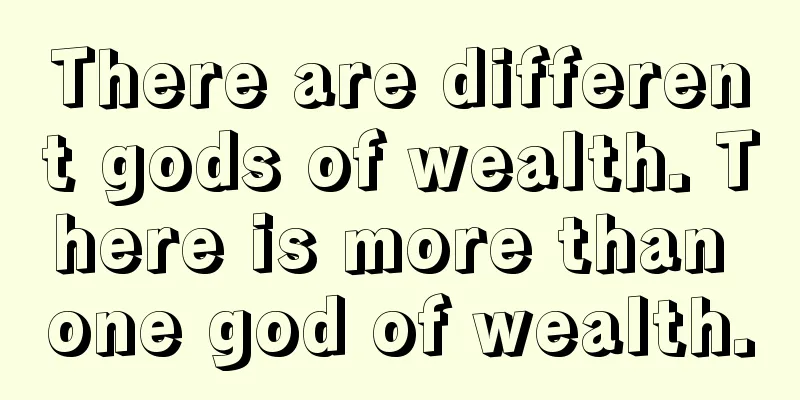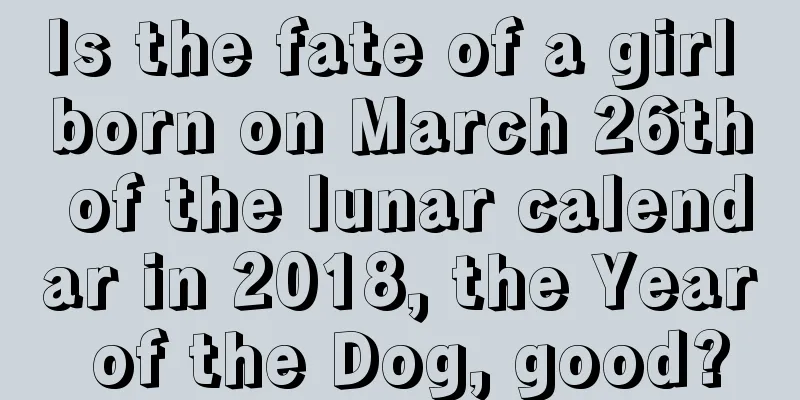There are different gods of wealth. There is more than one god of wealth.

|
Introduction: In Chinese folk legends, the God of Wealth is the deity in charge of financial resources. He can be divided into two main categories: one is bestowed by Taoism, and the other is Chinese folk belief. There is more than one God of Wealth. In our traditional culture, there are mainly three kinds of God of Wealth. Please see the introduction below for details. Let’s take a look at the issues that need to be paid attention to when having the God of Wealth at home. 1. Wen Caishen:1. Li Guizu, the God of Wealth: also known as the God of Wealth and Fortune. Li Guizu, the God of Wealth, is an official dressed in brocade clothes, with a jade belt around his waist. He holds a gold ingot in his left hand and a scroll with words "attracting wealth and treasure" in his right hand. He has a solemn appearance and is a symbol of unlimited wealth. According to legend, he is the Taibai star in the sky, known as the God of Gold. His title in heaven is "Dutian Zhifu Caibao Xingjun", who is in charge of all the gold, silver and wealth in the world. He looks kind and auspicious, and will grant any wish. He is a "universal" god of wealth that people like to worship the most. Of course, if you hold a public office and want to make more money, it is recommended that you worship Li Guizu, the God of Wealth. 2. The three gods of wealth, fortune, and longevity: The god of fortune bestows happiness on people based on their good deeds; the god of wealth governs the honor, wealth, and status of the human world; the god of longevity, also known as the old man, is in charge of the lifespan of the monarch and the country, and can also increase the lifespan of ordinary people. Commonly, the God of Fortune holds a "Fu" character in his hand, the God of Wealth holds a gold ingot, and the God of Longevity holds a longevity peach and leans on a cane. In addition, there is a symbolic way of painting bats, sika deer, and longevity peaches, using their homophones to express the meanings of blessing, wealth, and longevity. If there are elderly and children living at home, it is recommended that you worship the Three Stars of Fortune, Longevity and Happiness to increase the blessings of the children, your wealth and the longevity of the elderly. 3. Fan Li, the God of Wealth: also known by his courtesy name Shaobo, was born in poverty but was knowledgeable and talented. He worked hard throughout his life and accumulated tens of thousands of gold. He was good at business, good at managing money, and able to spend money widely. He became a wealthy man through business three times and gave away his wealth three times. He called himself Tao Zhugong and was the ancestor of Confucian businessmen in my country. People praised him: "He was loyal to his country, wise to protect himself, and used business to make himself rich and famous." He is revered as the God of Wealth for his ability to advance and retreat appropriately, his attitude of not being obsessed with fame and fortune, and his superb business skills. Therefore, it is recommended that Confucian merchants worship Fan Li, the God of Wealth, to bring prosperity. 2. God of Wealth:1. Zhao Gongming, the God of Wealth and War: Also known as Marshal Zhao Gongming, the statues of the God of Wealth and War enshrined in Taoist temples today are mostly depicted with a black face and thick beard, riding a black tiger, holding a silver whip in one hand and a gold ingot in the other, in full military uniform, that is, the statue of Marshal Zhao Gongming. People believe that Zhao Gongming is in charge of four minor gods related to wealth, namely Zhaobao, Nazhen, Zhaocai and Lishi, thus he becomes the God of Wealth. From the perspective of Zhouyi numerology, Zhao Gongming, the God of Wealth, has a black face and rides a black tiger, and his five elements belong to water. Therefore, it is believed that people in the "water" area in the north, the "gold" area in the west, and the "wood" area in the east are most suitable to worship Zhao Gongming, the God of Wealth. 2. Zhong Kui, the God of Wealth and War: Also known as “the Holy Lord who bestows blessings and protects the house.” Zhong Kui was born with a leopard head, round eyes, an iron face, curly beard, and a strange appearance; however, he was a talented and knowledgeable person. He was upright, upright, and honest to others. The God of Wealth Zhong Kui holds ingots in one hand and a sword in the other. It is widely said among the people: "To bless and protect the house, only Zhong Kui can be respected; to worship Zhong Kui, you will pass the exam and win the first place; to worship Zhong Kui, you will be able to drive away evil spirits, protect blessings and accumulate wealth, and increase your fortune and longevity." If you often encounter villains and your career is affected and your fortune is blocked because of this, it is recommended that you worship the God of Wealth, Zhong Kui, to suppress the villains and increase your fortune. 3. Guan Yu, the God of Wealth: Also known as Guan Gong, he has phoenix eyes and long brows, and is very majestic. He was loyal, brave, and steadfast throughout his life. He was not moved by gold, silver, or treasures, and was revered by Buddhism, Taoism, and Confucianism. Guan Yu is honored as Guan Shengdijun and Guan Erye among the gods in Chinese Taoism; he is honored as Galan Bodhisattva and Dharma Protector in Buddhism. Merchants admired Guan Gong's loyalty and trustworthiness, and regarded him as their patron saint for making money and worshipped him as the God of Wealth. From the perspective of Zhouyi numerology, the red-faced Guan Gong belongs to the fire element, so it is believed that people in the "fire" areas of the south and the "earth" areas of the Central Plains are most suitable to worship the God of Wealth Guan Gong in order to make money. 3. Five Gods of WealthAlso known as the Five-Surname God of Wealth, his Tibetan names are Zhanbalasepo, Zanbulugarbu, Zanbulunabu, Zhanbalawopo, and Zanghamapo. The colors of these five wealth gods are yellow, white, black, green and red. 1. White God of Wealth: It is said that he is the incarnation of Avalokitesvara Bodhisattva out of compassion. He is in charge of wisdom, merit and wealth. His body is white, which means that he can make all sentient beings have pure and wonderful treasures. The White God of Wealth wears a crown with five skulls and a flame on his head symbolizing anger. He has three eyes and a wide-open mouth. He holds a trident in his left hand and a short stick in his right hand. He sits on a dragon in a relaxed sitting posture, with the dragon's fangs and claws bared, its head and tail raised high. The dragon has four legs, and the front right foot is stepping on a round object. White represents gold and represents the west, so people living in the west are best suited to worship the White God of Wealth in order to increase their wealth. 2. Yellow Jambhala, the chief of all wealth gods, is in charge of wealth. He can lift all living beings out of poverty and bring them great wealth. The Yellow Jambhala has one face and two arms, and wears a five-Buddha crown as his headdress. He is short and has a big belly, and his arms are strong. He holds the Bula Gita in his right hand and a treasure-spitting rat in his left hand. He is dressed in celestial clothes, and is decorated with blue lotus and jeweled necklaces. He has a rosary on his chest. His left foot is bent, and his right foot is stepping on a conch shell. He sits on a lotus moon wheel in a wish-fulfilling posture. Because his body is yellow, he is called the Yellow God of Wealth. Yellow represents earth, so Yellow Jambhala is most suitable for believers in the Central Plains and the four corners to worship and bring wealth. 3. The Black God of Wealth is the one among the Five Gods of Wealth whose granting of wealth is immediate, so he is called the King of Wealth. This deity is short and fat, with a big belly and a blessed appearance. He has red hair, black skin, and is naked. His three eyes are wide open, and his hair, beard and eyebrows are as red as fire. He wears a crown on his head, and is decorated with jeweled necklaces and eight dragon kings. His genitals are erect, with a glow against his back. He has a thick body and a big belly. In his right hand, he holds a blood-filled skull vessel on his chest, and in his left hand he holds a treasure-spitting rat. He stands in a majestic posture with his feet bent to the right and stretched to the left. He steps on the back of a yellow god of wealth and rests on a lotus moon seat. Black represents water and represents the north, so people in the north worship the Black God of Wealth for the best fortune. 4. The Red God of Wealth originates from the hidden treasure tradition of Guru Padmasambhava. He can attract the merits of freedom and abundance in terms of people, wealth, food and other enjoyments. This statue has three faces, six arms and four legs. Its eyes can be either happy or angry. The front face is red, the right face is white, and the left face is blue. In his hands, he holds a treasure-spitting rat in front of his chest, and treasures are continuously spit out from his mouth. The other two hands on the right hold the Three Treasures and an iron hook respectively, and the two hands on the left hold a skull bowl full of treasures and a rope. He is decorated with eight dragons and treasures, wears a silk crown on his head, and has bouquets of flowers on his body. His legs are bent right and stretched right, and he is standing in a standing position, stepping on the male and female gods of wealth, and standing on a lotus moon wheel. Red represents fire and represents the south, so people in the south worship the red god of wealth for the best fortune. 5. Green God of Wealth is the incarnation of the Immovable Buddha of the East. He is entrusted by Sakyamuni to bestow worldly and Dharma wealth. The image of the Green God of Wealth is that he wears a red armor on his upper body, has one face and two arms, two kind and angry eyes, and is adorned with various treasures. He wears a white armor on his head and a precious necklace as his reward body. He holds a precious sword in his right hand, symbolizing the end of poverty, and holds a treasure-spitting rat in his left hand, symbolizing the increase of blessings. He rides a green divine horse with his right leg stretched out and bent, standing on a lotus throne. Green represents wood and represents the east, so people from the east are best suited to worship the Green God of Wealth in order to increase their wealth. |
<<: Teach you how to place the most auspicious God of Wealth
>>: 2016 Daily Fortune God Position Query Table
Recommend
When will the Qingming Festival in 2018 begin? What are the customs of Qingming Festival?
Introduction: Qingming Festival is not only an imp...
Is the 27th day of the 12th lunar month in 2019 a suitable day to sign a contract?
Is the 27th day of the 12th lunar month in 2019 a ...
What does it mean that Tiangongsheng is born on the ninth day of the first lunar month? Is the ninth day of the first lunar month in 2020 an auspicious day?
What does it mean that Tiangongsheng is born on th...
Can I visit the graves and worship my ancestors on the 16th day of the first lunar month?
By referring to festivals such as the Ghost Festiv...
When is the autumnal equinox in 2019? Why are the days shorter and the nights longer during the autumnal equinox?
The Autumnal Equinox is the sixteenth solar term i...
Can I get married on Halloween in 2021? What are the requirements for Halloween wedding decoration?
Everyone has a desire to get married. What will it...
Is it okay to decorate for Chinese Valentine’s Day on August 25, 2020? How to choose an auspicious day for breaking ground on renovation?
July 7 is known as the "Birthday of the Seven...
Where can Scorpios easily meet the right person during the Lantern Festival in 2017?
Introduction: The Lantern Festival is not only an ...
How is the 14th day of the first lunar month in 2022? Is it an unlucky day for the underworld?
The good and bad days in the lunar calendar are di...
Is it good to set up the bed one day after the Double Ninth Festival on September 10, 2020?
Introduction: It is also necessary to choose an au...
Is it suitable to move house on June 27th of the lunar calendar in 2022? Where should you not move to?
The sixth month of the lunar calendar is the last ...
Can I sign the contract on November 13th of the lunar calendar in 2021?
Signing a contract also requires choosing a time, ...
Can I move on Grain in Ear Day, June 5, 2021? Query of auspicious dates for moving into a new house
Moving is a happy occasion, and moving into a new ...
Is it a good day to travel on the fourth day of the fourth month of the lunar calendar in 2020? Is it a day of death?
Check the daily lunar calendar, good and bad luck,...
Detailed explanation of the Feng Shui of fish tank placement in the restaurant: the location of the fish tank is the key!
Introduction: The styles of modern restaurants are...









